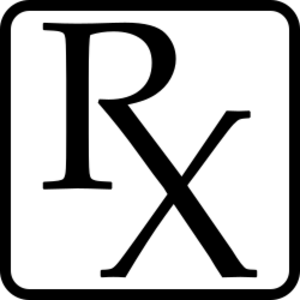Prescription facts for kids
A prescription is a special message from a doctor or another healthcare professional. It tells a patient what medicine they need or what treatment they should follow. Many medicines can only be bought with a prescription because they are very strong. You can't just pick them up from a pharmacy like you might with over-the-counter drugs (medicines you can buy without a doctor's note).
The symbol ℞, often seen as "Rx", is a short way to say "prescription." It comes from an old Latin word, "recipe", which means "take." When you get a prescription medicine, it usually comes with a paper called a Patient Information Leaflet (PIL). This paper gives you important details about the medicine, like what it's for, how to take it, and any possible side effects.
What is a Prescription?
A prescription is like a set of instructions from your doctor. It makes sure you get the right medicine at the right dose. Only certain trained healthcare professionals are allowed to write prescriptions. This includes doctors, dentists, and some types of nurses. They have special training to know which medicines are safe and helpful for different health problems. Medicines that need a prescription are sometimes called "legend drugs."
It's very important to use prescription medicines exactly as your doctor tells you. Using them incorrectly can be harmful to your health. Always follow the instructions on the label and read the information leaflet that comes with your medicine. This leaflet explains what the medicine does, how it works in your body, and any warnings, like if you have allergies.
You might also see products like herbal preparations, vitamins, and minerals. These are usually sold as dietary supplements and don't need a prescription. It's up to you to choose these products carefully, as they don't have the same strict rules as prescription medicines.
Medicines and the Environment
Sometimes, tiny amounts of medicines can end up in our drinking water. This can happen when people flush old medicines down the toilet or throw them in the trash, and they end up in sewage systems. Even after water is treated, some of these tiny bits of medicine can remain.
When these small amounts of medicines get into rivers and lakes, they can affect fish and other aquatic organisms (animals that live in water). Because many medicines dissolve easily in water, these animals can be exposed to them. Scientists are studying how this might affect their survival and ability to have babies over a long time.
While the amount of medicine in our drinking water is usually very low and not a direct problem for human health, it's still important to protect our environment. To help reduce medicine waste in water, it's best not to flush old medicines down the toilet. Instead, look for special programs that collect old medicines, often called "medication take-back programs." This helps keep our water cleaner for everyone and for the animals that live in it.
See also
 In Spanish: Prescripción para niños
In Spanish: Prescripción para niños
- Package insert
- Pharmacy (shop)
- Pharmacy automation


